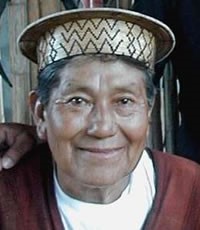The people live mostly on three rivers, the Ene and Perene rivers and the Tambo that is formed by those two tributaries. There are isolated groups that live away from the rivers and a few on the Urabamba that joins with the Tambo to form the Ucayali which is the main tributary of the Amazon.
A typical village is along the river with two long rows of houses with a school and a soccer field at one end or often in the middle. Their typical house has a palm leaf thatched roof and a raised floor of split palm trunk. Most do not have walls and they sleep inside of mosquito nets both for the insects and for privacy. They are a hard-working people who mostly hunt and fish for meat and grow bananas and yucca which are part of their main diet. They hunt with shotguns and arrows for game that is increasingly difficult to find.
Many of them now wear Western clothing but many still wear their hand-woven typical gown which is essentially a large sack with holes for the head and arms and goes down past the knees. The main difference between men's and women's is that the men's have vertical stripes and the women have horizontal stripes. Often both men and women will paint their faces with a bright red seed called achote that they boil down into a paste. They will either paint their face all red or red horizontal stripes or black stripes. Often the women will dye their hands feet and heads a deep blue with a natural dye.
They do not have bank accounts or save money so if they need to buy something, they will plant a field and harvest and make the purchase after selling. Otherwise they often trade chickens, animal skins, lumber off their land or other resources with traveling merchants for kettles, axes, machetes, shotgun shells, fishing line and other needed items. Many villages now have small stores of their own. Their culture makes it difficult to successfully operate a store or a small engine repair shop for the numerous motors they use for river transportation because the worst thing a man can do (besides stealing someone's wife) is to be stingy. They trade and share among themselves and stealing is very uncommon, though as modern culture creeps in all these good attributes suffer.
As they are community oriented they are also shame conscious instead of guilt conscious. They laugh a lot and use it to cover up embarrassment, pain and other emotions. If you try and say something in their language they will all laugh very hard even if it is just because they are pleased that you tried. Both parents are involved in raising kids but if you see them walking on a trail it will be single file with the man 10 to 20 feet in front holding a shotgun and a machete and the wife with the kids around her, one in a sling nursing and at the same time she will have a basket on her back held up by a strap around the top of her head full of their stuff. She looks like a beast of burden and he the mighty warrior.
Children grow up not wearing shoes and very little ones are considered dressed if they have only a shirt on. It is not uncommon to see the little kids go naked. They are a very modest people and they do not consider it immodest for a woman to walk around her own home outside in the evenings without a top of any kind on. Men and women will have their own times of bathing in the streams or river and a woman will walk in with her 'sack' dress on, take it off in the water and put it back on as she comes out. The kids all just bathe naked together until puberty.
For the most part they are a very happy people and their children are obedient. When a girl reaches puberty they will cut all her hair off and she will wear a head scarf. When it grows out she can be married off, very often at about 14 years old. The arrangement is usually made with the father and almost always with the girl's consent, though she may just be sent off with her new husband without being asked. New customs from the Peruvian Mestizos and more education have greatly impacted how and when they get married and has brought a very negative trend in many unwed young mothers.
They are Animists and the spirits of animals and nature is very real to them. They lived in fear of these spirits who control them in that way. They also have individual names for each type of animal and do not group them as we do. For example, each bird has its own name rather than calling them all birds like we do. The same is true for fish, though they do have a generic name but do not often use it. Trees are the same as are many other things in nature around them.
Their language has very few words compared to what we call modern languages. For example they have only one word for our words of: nice, pretty, lovely, beautiful, pleasant, gorgeous, delicious and so on. They can only say that it is good. They do not have a word for sin like we do, with the many other ways to say it. They only say that it is not good. There are over 60 villages on these rivers and most have functioning Evangelical Churches. There are at least two Catholic villages and one Seventh Day Adventist village and on the Ene River a number of villages have been taken over by aggressive fringe Pentecostals that call themselves "Jesus Only."
Scripture Prayers for the Ashaninka in Peru.
| Profile Source: Mark Friesen |










